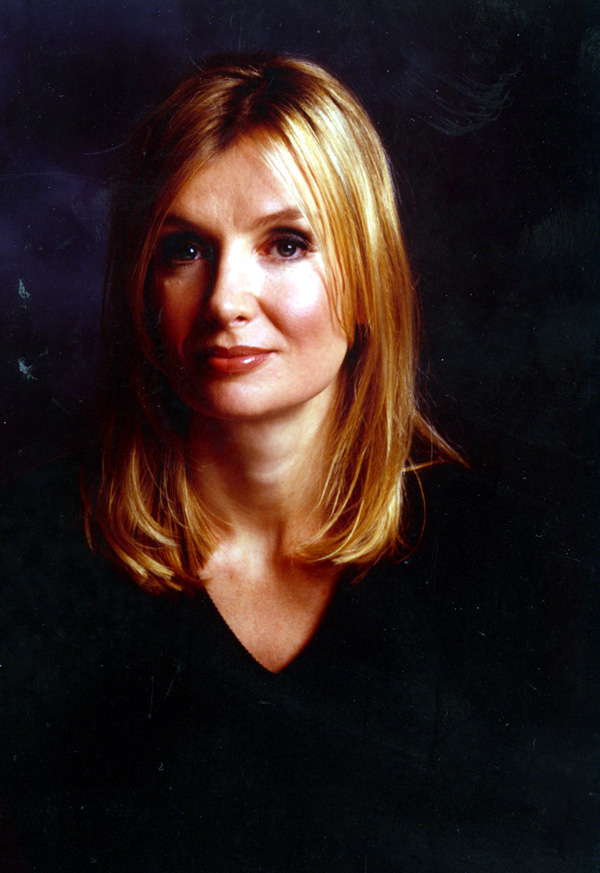SITE CONTENTS
BUY MO HAYDER'S BOOKS
FROM AMAZON
|
|
A White Knuckle Ride |
with MO HAYDER |
| interviewed by Christine Campbell |
 |
The
Treatment is the continuation of Mo Hayder’s debut best seller
Birdman, featuring DI Jack Caffrey of the Met’s murder squad.
Although each book can be read separately, they are better described
a two parts of a body of work. Both books delve into aspects of
human nature that we try and isolate, suppress and package away in a
newspaper headline. With expressive violence and descriptive
torture, not only of the characters but also of the reader, who is
plunged into the dark world of debased human nature, I approached my
interview with Mo Hyder with expected temerity. I found reading both
books difficult and at times distasteful, struggling to get past the
bare-faced violence to the tightly wound plot and overall study of a
man stripped of everything, leaving him faced with his own morality.
At her own admittance Mo Hayder deliberately pushed the boundaries
of the typical crime novel to explore the grey areas of the flawed
hero, telling a tale of choices and actions and the consequences of
them. The introduction of Jack in Birdman along with the
establishment of his personal mystery and the interwoven official
crime is built upon in The Treatment drawing his personal and
professional worlds so closely together that they feed upon each
other. The search for what happened to his brother Ewen, is the
single most defining characteristic of Jack. This obsession that has
driven him since that day his brother disappeared envelopes The
Treatment to become the primary subject matter. Jack’s
investigation of a missing boy in Brixton, draws him into the world
of the paedophile, both that of Pendrecki, the man he suspects took
his brother, and that of those involved in the disappearance of the
boy in Brixton.
Mo Hayder deliberately chose paedaphilia as the defining crime in
this novel, not only to give her a forum in which to explore Ewen’s
story further but a way to probe into the family unit. Most cases of
paedaphilia involve a person known to the child, and with this in
mind Hayder explores “the dark view of family life”. This
disintegration of the family is not only limited to Jack’s own
family and those victim of the crimes he is investigating, but to
any family portrayed in the book, as Hayder says, this theme is
introduced due to”her reaction against the hypocrisy of perfect
families” that are reinforced by the media and society. This
rebellion against the boundaries society places around themselves is
a major factor behind the excesses within the novel. Hayder seems to
exorcise her need to breakdown these boundaries not only by the
intensity violent descriptions, but also by the plot structure and
character development, pushing the reader into the uncomfortable and
difficult, - capturing them like a witness that cannot turn away
from an accident that they can see is going to happen.
Surrounding this tightly woven plot and intense study of human
nature is South London. Hayder takes the preconceived notions of
Brixton and other South London locals, and throws them away,
exposing communities that are more than the headline in the
newspaper depicting another gang orientated death. The constantly
changing urban environment seeps into the novel, adding to the
layers of realism and the fear that the story unfolding could quite
easily have happened. Hayder may push the boundaries of description
and plot developments, however while she was researching and
planning the novel, the Sarah Payne story broke, holding the
newspapers hostage as well as the public.
This high profile case caused Hayder to hesitate about continuing
the novel, however she felt that although these are difficult
issues, there is still a need to deal with it. Hayder has a healthy
respect for the reader as she said, “ I don’t like to
narrate feelings for readers, they need to make up their own minds.”
This approach adds to Hayder’s step away from underpinning the
story by moral message. She overturns the traditional approach of
the crime novel especially with a central character like Jack
Caffrey. Jack walks a fine line between good and evil, his actions
in his personal and professional life go even further than the hard
boiled protagonists of the noir crime genre.
Jack’s actions are not placed in isolation as a plot mechanic,
as Hayder dissects human nature further by having the consequences
of these actions impact the story even more. Just as we are as
readers will never be aware of some of the repercussions of all our
actions, Hayder illustrates this realistic aspect of life within
these two novels not only with Jack but with all the characters.
These characters surrounding Jack Caffrey are well rounded and are
as multi layered., however they are just that - surrounding Jack.
This story is essentially about one man, each character is a
reflection, an alternative or have another function in telling his
story. The under lying factor is that The Treatment essentially
gives a conclusion to the mission driving Jack Caffrey’s life.
It leaves the reader satisfied with their final glimpse of him.
This is going to be the last Mo Hayder book featuring Jack Caffrey.
Hayder is writing her third novel, drawing on her experiences in
Japan, where she lived for two years. She will take a step even
further away from crime as this novel will be more of a thriller
with less of the description heavy violence that dominated her
previous novels. She would give no other clues about it, however I
look forward to reading it as the promise of less expressive
violence and descriptive torture, wll ensure that this reader will
find it easier to delve into the rich text of this talented writer.
 |
|